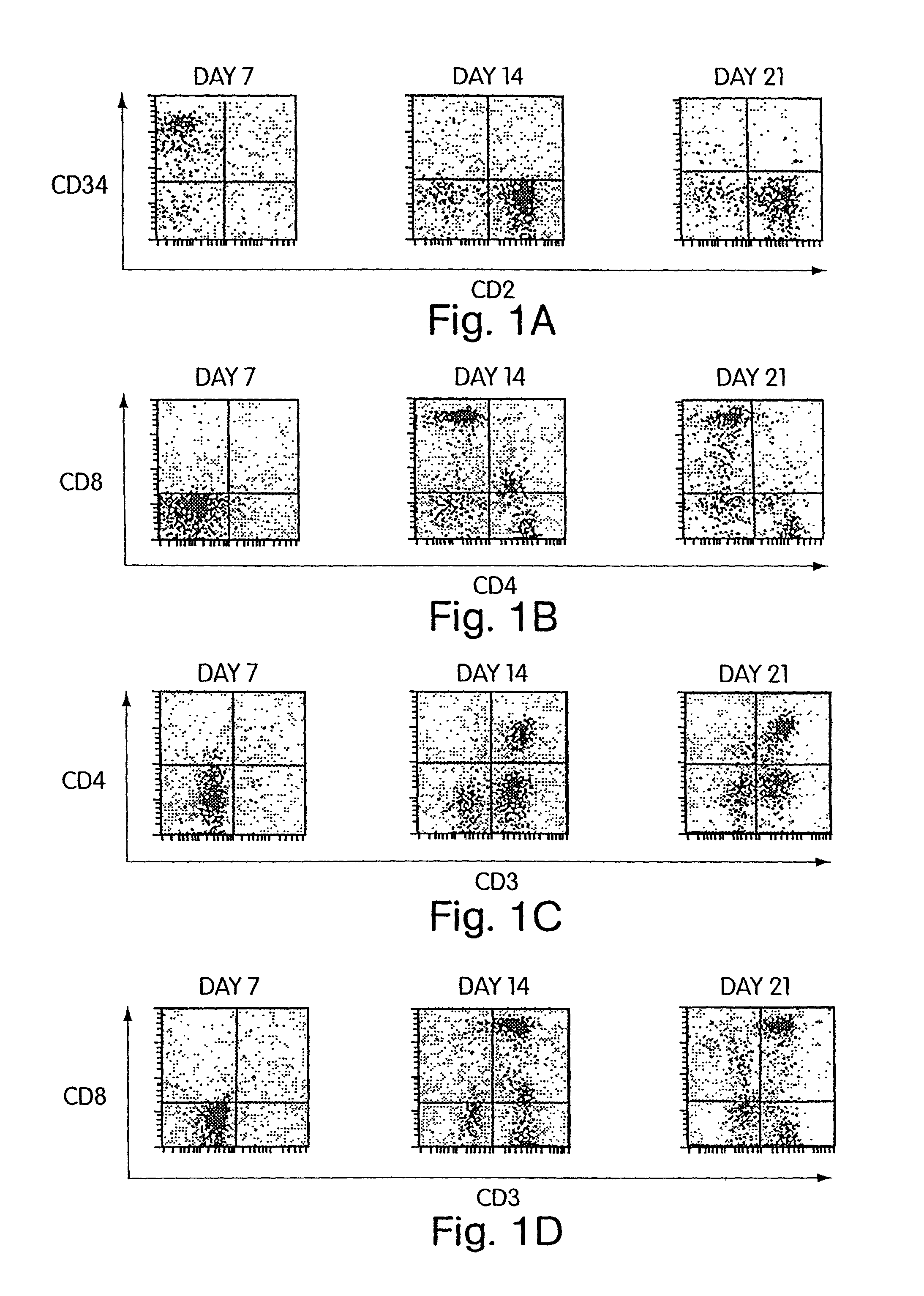Lymphoid tissue-specific cell production from hematopoietic progenitor cells in three-dimensional devices
- Summary
- Abstract
- Description
- Claims
- Application Information
AI Technical Summary
Benefits of technology
Problems solved by technology
Method used
Image
Examples
example 1
Viability, Immunophenotype and Function of Human Cells Generated in Co-Culture Systems
[0135]The numbers of viable cells generated in the co-culture system and their immunophenotype are shown in Table 5. Maximal human T cell proliferation was seen when human fetal thymic CD34+ cells and UCB CD34+ cells were co-cultured with murine fetal thymic stroma grown on Cellfoam. Data generated from a direct comparison of co-culture of CD34+ cells on murine thymic stroma on cell foam versus co-culture of CD34+ cells on murine stroma grown as a simple monolayer are also shown in Table 5.
[0136]T cells generated in the co-culture system were also shown to be injectable by T-tropic HIV-1IIIB and these cells were also transductible at a transduction efficiency of 12–22% (n=3) with MFG vector.
example 2
Maintenance of Immature Progenitor Cells
[0137]According to the invention, it has also been discovered that Cellfoam cultures of thymic stromal cells are able to induce T cell differentiation of CD34+ progenitors and yet preserve a fraction of CD34+ cells. Primate CD34+ progenitors were cultured on either human or swine thymus that had been established on Cellfoam tissue scaffolds. After 14–21 days, CD3+CD4+CD8+ triple positive cells and CD3+CD4+ and CD3+CD8+ double positive cells are reliably recovered. In addition, the CD3− cell fraction was found to contain CD34+ progenitor cells after 14–21 days. These CD34+ cells not only were CD3−, but many were also CD2+. This demonstrates that thymus cultures in Cellfoam tissue scaffolds can support T cell differentiation while simultaneously preserving the long-lived CD34+ progenitor cell population. As will be evident to those skilled in the art, this surprising finding indicates that ongoing differentiation of T progeny while maintaining i...
example 3
T Cell Function (Proliferation / Anergy) Assays
[0138]T cell function is evaluated by the proliferative potential to specific and non-specific antigens using standard assays. Specifically, the assay assesses the response of T cell receptor (TCR) mediated proliferation using anti-CD3 antibodies (Becton Dickinson) as well as baseline non-specific proliferation using concavalin A (Con-A). Briefly, T cells are washed and resuspended in RPMI with 10% FCS at a concentration of 106 cells / ml. 100 μl (105 cells) are added to each well of a 96 well plate. Cells are stimulated with either Con-A (5 μg / ml) (non-specific response) or monoclonal antibodies to CD3 in the presence of IL-2 (20 units / ml) and irradiated mononuclear cells (MCs) (105 cells / well in 100 ml of RPMI with 10% FCS). Purified goat anti-mouse F(ab′)2 fragments (Kirkegard and Perry Laboratories, Gaithersberg, Md.) are used as a crosslinking agent for the experimental conditions where monoclonal antibodies to CD3 are used. Wells are ...
PUM
| Property | Measurement | Unit |
|---|---|---|
| Time | aaaaa | aaaaa |
Abstract
Description
Claims
Application Information
 Login to View More
Login to View More - R&D
- Intellectual Property
- Life Sciences
- Materials
- Tech Scout
- Unparalleled Data Quality
- Higher Quality Content
- 60% Fewer Hallucinations
Browse by: Latest US Patents, China's latest patents, Technical Efficacy Thesaurus, Application Domain, Technology Topic, Popular Technical Reports.
© 2025 PatSnap. All rights reserved.Legal|Privacy policy|Modern Slavery Act Transparency Statement|Sitemap|About US| Contact US: help@patsnap.com


